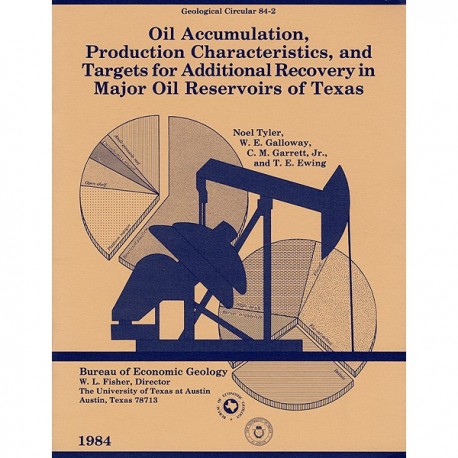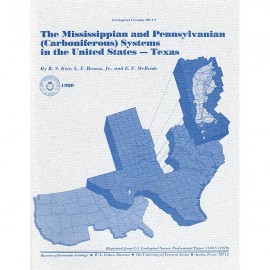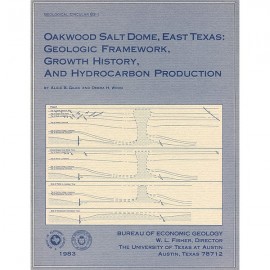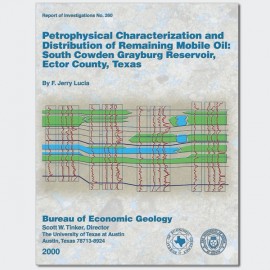Geological Circulars
-
Books & Reports
- Reports of Investigations
- Guidebooks
- Udden Series
- Geological Circulars
- Down To Earth
- Atlases of Major Oil and Gas Reservoirs
- Texas Memorial Museum Publications
- Environmental Geologic Atlas of the Texas Coastal Zone
- Mineral Resource Circulars
- Other Reports
- Seminars and Workshops
- Handbooks
- Submerged Lands of Texas
- Symposia
- Annual Reports
- Open File Reports
-
Maps & Cross Sections
- Thematic Maps
- Miscellaneous Maps, Charts & Sections
- Geologic Atlas of Texas
- STATEMAP Project Maps
- Geologic Quadrangle Maps
- Cross Sections
- Highway Geology Map
- Energy and Mineral Resource Maps
- Shoreline Change and Other Posters
- Wilcox Group, East Texas, Geological / Hydrological Folios
- Bouguer Gravity Atlas of Texas
- River Basin Regional Studies
- Featured Maps
- Posters
- Teachers & the Public
-
Geological Society Publications
- Gulf Coast Association of Geological Societies
- Alabama Geological Society
- Austin Geological Society
- Corpus Christi Geological Society
- Houston Geological Society
- Lafayette Geological Society
- Mississippi Geological Society
- New Orleans Geological Society
- South Texas Geological Society
- GCS SEPM Publications
- Historic BEG & UT Series
Oil Accumulation, Production Characteristics, and Targets for Additional Recovery in Major Oil Reservoirs of Texas
GC8402
A free, digital version of this publication can be found on: Texas ScholarWorks
GC8402. Oil Accumulation, Production Characteristics, and Targets for Additional Recovery in Major Oil Reservoirs of Texas, by Noel Tyler, W. E. Galloway, C. M. Garrett, Jr., and T. E. Ewing. 31 p., 16 figs., 6 tables, 1 appendix, 1984. ISSN: 0082-3309. Print.
To purchase this publication as a PDF download, please order GC8402D.
ABSTRACT
Characterization of 500 of the largest Texas oil reservoirs permits grouping into plays of similar geology and common engineering and production attributes. Most of the major oil reservoirs of Texas are included in 48 plays, which account for 71 percent (32 billion barrels cumulative) of all historical production in Texas. Twenty-seven oil plays lie north and west of the Marathon-Ouachita structural front in Paleozoic reservoirs that are predominantly dolomite and that contained 73 percent of the original oil in place (OOIP) in Texas. Most of the oil in these Paleozoic plays is trapped in restricted-platform and, to a lesser extent, in platform margin and atoll reef carbonate systems and in deep-water slope and basinal clastic systems of the Permian Basin. Recovery efficiencies of the Paleozoic plays are considerably lower than are those of the 21 Mesozoic and Cenozoic plays of the Gulf Coast and East Texas Basins.
Major reservoirs in Cretaceous and Tertiary plays were deposited principally in deltaic and barrier-strandplain systems. Reservoir genesis clearly influenced patterns of hydrocarbon accumulation and recovery. In-place oil in clastic reservoirs is distributed fairly evenly among fluvial/deltaic, deltaic, barrier-strandplain, and slope and basinal sandstones. Recoveries from clastic facies in Texas are dominated by production from deltaic reservoirs, which are projected to ultimately produce almost half (47 percent) of all oil obtained from clastic reservoirs. Slope/basin sandstones, in contrast, contained one quarter of the OOIP in clastic facies but will produce only 5 percent of the total obtained from Texas' clastic reservoirs. The statewide weighted average recovery from sandstone reservoirs is 41 percent. Weighted average recoveries by play range from a low of 8 percent from slope/basin systems to a high of 68 percent from deltaic plays.
Original in-place oil is less uniformly distributed among carbonate reservoir facies than among clastic reservoir facies. Restricted-platform plays trapped 61 percent of the OOIP in carbonate reservoirs, whereas platform-margin and deep-water carbonate reservoirs held 16 and 11 percent, respectively. Oil recovery from restricted-platform carbonates is relatively poor; only 30 percent of the original resource will be produced by primary or secondary methods from these plays. Deep-water atoll and pinnacle-reef reservoirs exhibit the best recoveries (50 percent), largely because of successful secondary recovery programs begun early in field development.
The potential target for additional oil recovery from major Texas reservoirs in which depositional or diagenetic complexity significantly limits recovery is 20 billion barrels. Most of this target oil is trapped in restricted-platform carbonates and slope/basin sandstones of the Permian Basin.
Keywords: Texas, major oil reservoirs, oil accumulation trends, oil recovery, targets for additional oil recovery, oil plays
Citation
Tyler, Noel, Galloway, W. E., Garrett, C. M., Jr., and Ewing, T. E., 1984, Oil Accumulation, Production Characteristics, and Targets for Additional Recovery in Major Oil Reservoirs of Texas: The University of Texas at Austin, Bureau of Economic Geology, Geological Circular 84-2, 31 p.






